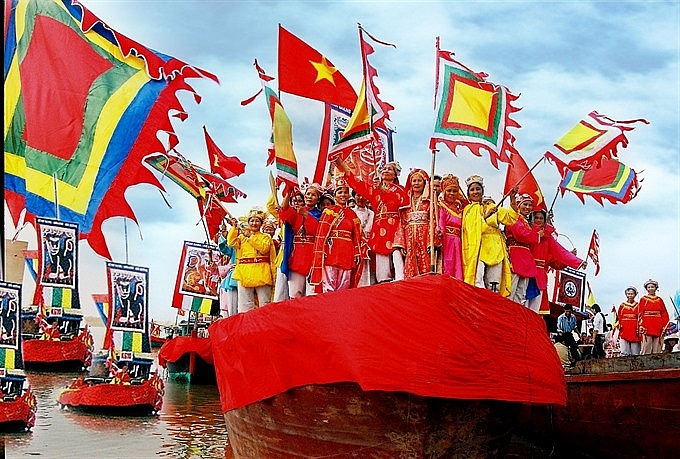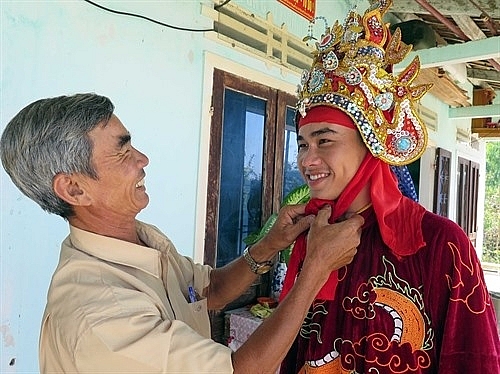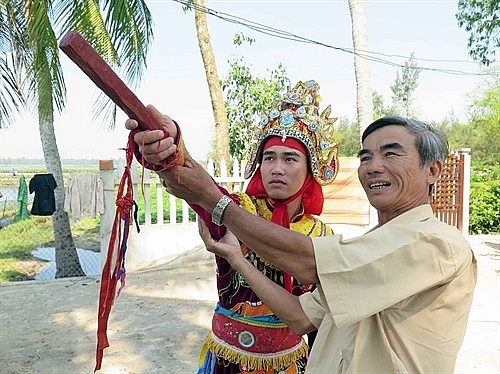Ba Trao singing passed down generations
 |
| Ba Trao singing is popular in central provinces including Quang Binh, Quang Tri, Thua Thien Hue and Quang Nam – Danang to Binh Thuan. hotrodulich.com |
On the third day of the Lunar New Year, thousands flocked to the south central province of Quang Ngai’s Sa Huynh seaport. The opening of the sea festival has begun with the sound of hundreds of drums played by local fishermen.
According to the province’s history, bả trạo singing is popular in the central provinces, from Quang Ngai, Quang Binh, Quang Tri, Thua Thien Hue, and Quang Nam - Danang to Binh Thuan.
Accompanied by dancing, the singing, held annually to worship the whale, who is traditionally called the “Big Fish”. In the past, they also prayed for a good harvest.
The purpose of the singing is to praise the Big Whale for saving lives, assisting the fishermen to catch large amounts of fish, or describing the painstaking labour of fishermen, as well as praising the wealth of the sea and solidarity of boatmen to have prosperous lives. Also, singers and local residents pray for peace and prosperity, as an act of reverence for the Whale God.
Nguyen Thanh Trung, who was selected by local fishermen of Quang Nam’s Tam Thanh Commune, Tam Ky City as Tong Mui (the captain of the boat), is the main singer at this year’s festival.
“The members of a typical bả trạo troupe include Tong Mui (the captain), Tong Khoang (the caretaker of all things on the boat), Tong Lai (the main boatman), and 10 to 16 other boatmen, depending upon the arrangements of each province, though the number has to be even,” said Trung.
“Tong Lai usually wears a traditional long black dress, long white trousers, and ready-to-wear black turbans. Tong Mui dresses like Tong Lai, but many times he or she wears radiant outfits, such as a tuồng (classical drama) actor.”
 |
| Tân’s devotion for traditional art contributes to the preservation and development of bả trạo singings |
Each province’s boat teams have 12 to 16 people, even 18 or maximum 20 people and especially even numbers to balance the formation.
Boatmen wear white outfits, red fabric tied at the back, walking barefoot and carrying one-metre long paddles, painted black and white. The musical instruments accompanying the bả trạo singing are đàn nhị (Vietnamese two-chord fiddle), a drum, trumpet and senh(an instrument combining clapper, rasp, and jingle made from three pieces of wood).
“I feel lucky and blessed to be chosen as captain of the singing. It is such a great honour for me and I want to pass my experience to younger singers,” said Trung.
Sixty-year-old Do My Tan, who lives in Quang Nam’s Vinh Giang Hamlet, Thang Binh District, has spent 40 years singing Ba Trao.
“It took seven years to study and practise the art, if you are truly committed to it. I have been the captain of the bả trạo singing troupe in my homeland ever since I was young. I usually write the lyrics and take part in choreographing the singing and dancing for local provinces on festive occasions,” noted Tan.
In bả trạo, the most important figure is the captain. This dignified character plays a significant role in controlling the entire troupe, like a conductor in an orchestra. You have to have a deep knowledge of the art, a tenor voice and a disciplined spirit. If the captain misses the right note, it will ruin the whole performance.
“Languages used in the singing are originated from ancient Vietnamese scripts and local dialects, but still remain the unique and spiritual meaning of each province. Currently, I train young people everyday so the tradition will always be passed down to the next generation,” he said.
The passion and devotion for traditional art in Trung, Tan and other boatmen and fishermen are contributing to the preservation and development of the folk singing, a cultural treasure of the nation.
 |
| Do My Tan (right) instructs a young singer in a Ba Trao performance. |
What the stars mean:
★ Poor ★ ★ Promising ★★★ Good ★★★★ Very good ★★★★★ Exceptional
Related Contents
Latest News
More News
- Free tickets, Lunar New Year promotions on offer at Vietjet Mega Livestream (November 26, 2025 | 15:32)
- UNIQLO unveils upgraded heat-retention wear at Hanoi event (October 26, 2025 | 10:00)
- Vietnam named among world’s top four culinary destinations (October 24, 2025 | 17:09)
- Vietnam and Denmark strengthen dialogue on sustainable fashion (October 20, 2025 | 09:11)
- Fusion rolls out special initiatives to celebrate Vietnamese Women’s Day (October 17, 2025 | 20:00)
- Showcase AC 2025 set to light up Hanoi stage (September 12, 2025 | 18:06)
- Hotel Indigo Saigon The City hosts event to reimagine city’s beloved alleyways (July 23, 2025 | 17:04)
- UNIQLO’s sustainability strategy behind the brand's global growth (June 23, 2025 | 15:42)
- Vietnam International Travel Mart 2025 kicks-off in Hanoi (April 10, 2025 | 17:50)
- Phu Quoc named as one of Asia's 'Best Islands' (March 13, 2025 | 10:24)

 Tag:
Tag:





















 Mobile Version
Mobile Version